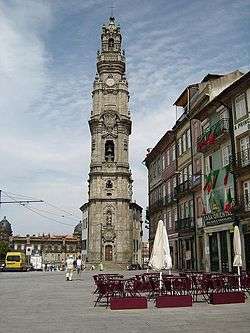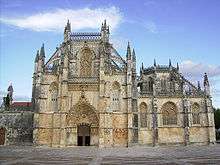Baroque architecture in Portugal
Baroque architecture in Portugal lasted about two centuries (the late seventeenth century and eighteenth century). The reigns of John V and Joseph I had increased imports of gold and diamonds, in a period called Royal Absolutism or Absolute monarchy, which allowed the Portuguese Baroque to flourish.
.jpg)
Baroque architecture
Baroque architecture in Portugal enjoys a very special situation and a different timeline from the rest of Europe. It is conditioned by several political, artistic and economic factors, that originate several phases, and different kinds of outside influences, resulting in a unique blend,[1] often misunderstood by those looking for Italian art, but with specific forms and character. It starts in a complicated moment, with the financial effort of the kingdom channelled to the Portuguese Restoration War, after 60 years of Iberian Union.
Another key factor is the existence of the Jesuitical architecture, also called "plain style" (Estilo Chão).
The buildings are single-room basilicas, deep main chapel, lateral chapels (with small doors for communication), without interior and exterior decoration, very simple portal and windows. It is a very practical building, allowing it to be built throughout the empire with minor adjustments, and prepared to be decorated later or when economic resources are available. Actually the first Portuguese Baroque does not lack in building because "plain style"” is easy to be transformed, by means of decoration (painting, tiling, etc.), turning empty areas in pompous baroque scenarios. The same could be applied to the exterior. Subsequently, it is easy to adapt the building to the taste of the time and place. Practical and economical.
The International Baroque
After the end of the restoration of independence war, and past the crisis of succession between Afonso VI and Pedro II, Portugal was ready for the international Baroque. It started gradually, changing the Mannerist model, trying to animate and modernise the new buildings, using the centred plant and some decoration, such as in the Church of Santa Engrácia in Lisbon, designed by João Nunes Tinoco and João Antunes.
Santa Engrácia is an impressive building, made with curves and geometric forms, a centred plant, crowned by a large dome (completed only in the twentieth century), decorated with colourful marbles and imposing itself to the city.
In the reign of King John V, the Baroque underwent a time of splendour and wealth completely new in Portugal. Despite the destruction wreaked by the 1755 earthquake, the quality of the buildings which have survived to our days is still impressive. The Palácio da Ribeira, the Royal Chapel (both destroyed in the earthquake) and the Mafra National Palace, are the main works of the King. The Águas Livres Aqueduct brings water to Lisbon covering a distance of 11.18 miles, with emphasis on the section over the Alcântara valley because of the monumentality of the imposing arches. However, across the country, are still visible marks of the pomp of the time in major or small works.
The gilded woodcarving [2][3] took on national characteristics because of the significance and richness of the decorations. The painting, sculpture, decorative arts and tiling also experienced great development.[4] One of the most opulent examples of gilded woodcarving from this period, is the Biblioteca Joanina, (Johannine Library, named after King John V) built in the main University of Coimbra old building and tower parade.[5] Numerous less known works exist throughout the country, namely in Viseu, Santarém and Faro.[6][7]
Palace of Mafra
.jpg)
The Palace of Mafra is the most international Portuguese Baroque building and, following the fashion among European monarchs, reflects the absolutist architecture, like the Palace of Versailles in France. It is a royal palace, a cathedral and a monastery, built after a promise made by the king related to his succession. Designed by João Frederico Ludovice, a German architect established in Portugal, the work began in 1717 and ended in 1730. It is an immense building with two turrets on the façade, after the destroyed turret in the Ribeira Palace, with the basilica at the centre and two bell towers dominated by an imposing dome. Behind that, although it cannot be seen from the street, is the monastery. The set is visible from the sea, working as a territorial milestone, and used as a summer residence for the court. It is known that the king wanted to build a church even greater than the Vatican, but after knowing that it took more than a century, he changed his mind. In the whole complex noteworthy are also the library, the six organs of the basilica and the two carillons.
Northern Portugal
.jpg)
In the north of Portugal there are numerous Baroque buildings. With more inhabitants and better economic resources, the north, particularly the areas of Porto and Braga,[8] witnessed an architectural renewal, visible in the large list of churches, convents and palaces built by the aristocracy.
The city of Porto (classified heritage of humanity by UNESCO) is the city of Baroque in Portugal. It is the working area of Nicolau Nasoni, an Italian architect living in Portugal, drawing original buildings with scenographic emplacement as the church and tower of Clérigos, the logia of the Porto Cathedral, the church of Misericórdia, the Palace of São João Novo, the Palace of Freixo, the Episcopal Palace along with many others.
See also
- Architecture of Portugal
- Baroque in Brazil
- Gilded woodcarving
References
- "Age of the Baroque in Portugal".
- "Altares de Talha Dourada".
- "A Talha Barroca de Lisboa ( 1670 - 1720)" (PDF).
- https://books.google.co.uk/books?id=DxqEWRgLqQ4C&pg=PT47&lpg=PT47&dq=o+barroco+talha+dourada+portugal+academia&source=bl&ots=wdnMspO1r-&sig=ACfU3U1lbMawW7LNjbWvLtK_Cf5hCLd-6A&hl=en&sa=X&ved=2ahUKEwigm-TOutHnAhVFnVwKHQcSDNMQ6AEwDHoECAoQAQ#v=onepage&q=o%20barroco%20talha%20dourada%20portugal%20academia&f=false
- "A Biblioteca de Dom João V".
- pesquisa-do-patrimonio/classificado-ou-em-vias-de-classificacao/geral/view/155968
- https://sapientia.ualg.pt/bitstream/10400.1/7125/4/PROM03_pp287-316.pdf
- https://www.jstor.org/stable/987760?seq=1

